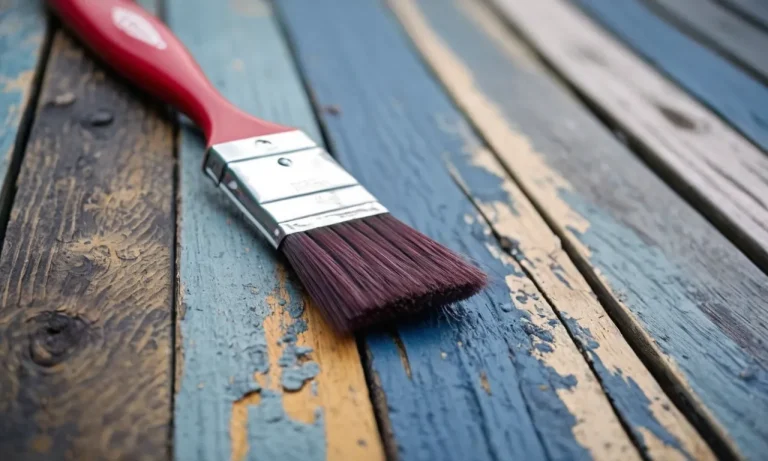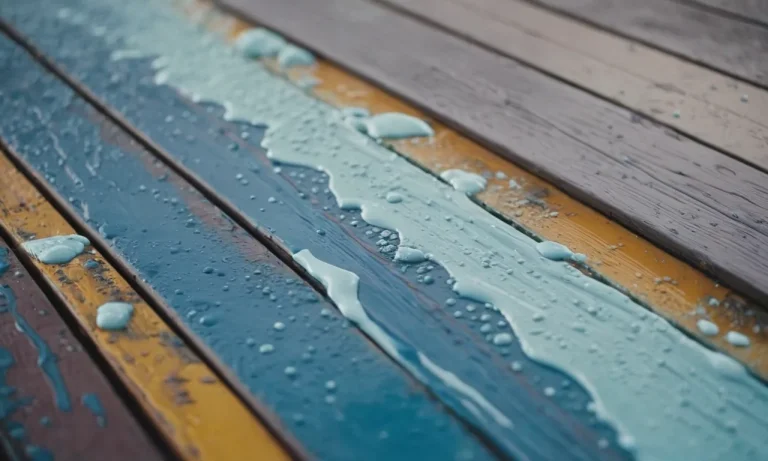Cheapest Way To Level Concrete Floor
Leveling an uneven concrete floor can be a daunting and expensive task, but with the right approach, you can get the job done efficiently and on a budget. If you’re looking to save money, here’s a quick answer: self-leveling concrete is often the most affordable method for DIYers to level concrete.
In this comprehensive guide, we’ll walk through everything you need to know to level concrete flooring yourself using self-leveling concrete, from prepping the slab and estimating materials to pouring and finishing the leveling compound. We’ll also provide tips to keep costs down.
Read on to learn the cheapest way to smooth and flatten bumpy, uneven concrete slab floors.
Assess the Concrete and Plan Your Project
Before starting any concrete leveling project, it is important to assess the condition of the concrete and plan accordingly. This will ensure that you choose the cheapest and most effective method to level your concrete floor.
Check for cracks and damage
The first step in assessing the concrete is to check for any cracks or damage. Cracks can be indicative of underlying issues that need to be addressed before leveling the floor. If there are only minor cracks, they can usually be repaired with a concrete crack filler.
However, if there are major cracks or structural issues, it is best to consult a professional for guidance.
Determine the highest and lowest spots
Next, you need to determine the highest and lowest spots on the concrete floor. This can be done by using a long straight edge, like a level or a piece of lumber, and placing it on different areas of the floor.
By measuring the gaps between the straight edge and the floor, you can identify the areas that need to be leveled.
Calculate how much self-leveling compound you need
Once you have assessed the condition of the concrete and identified the areas that need to be leveled, it is time to calculate how much self-leveling compound you will need. Self-leveling compound is a popular choice for leveling concrete floors as it is easy to use and provides a smooth finish.
To calculate the amount needed, you will need to measure the square footage of the area that requires leveling and refer to the manufacturer’s instructions for the recommended coverage rate.
It is worth noting that the cost of leveling a concrete floor can vary depending on factors such as the extent of damage, the size of the area, and the method chosen. For a more accurate estimate, it is advisable to consult with professionals or refer to reputable websites such as HomeAdvisor.com or Angie’s List.
Prep the Concrete Slab
Clean the floor thoroughly
Before leveling a concrete floor, it’s important to clean it thoroughly to ensure proper adhesion of any leveling materials. Start by removing any loose debris, such as dirt, dust, and small rocks. You can use a broom or vacuum cleaner to sweep the floor and then mop it with a mild detergent solution.
Make sure to remove any grease or oil stains using an appropriate cleaner. A clean surface will provide a better foundation for leveling.
Repair cracks and holes
If your concrete floor has any cracks or holes, it’s essential to repair them before leveling. Cracks and holes can compromise the integrity of the leveling material and lead to uneven results. Use a concrete patching compound to fill in any cracks or holes.
Follow the manufacturer’s instructions for the specific product you choose. Allow the patching compound to dry completely before moving on to the next step.
Roughen up the surface
To ensure proper adhesion of the leveling material, it’s important to roughen up the surface of the concrete floor. You can use a floor grinder or a shot blaster to create a rough texture. This will help the leveling material adhere better and prevent it from peeling or cracking over time.
Be sure to wear appropriate safety gear, such as goggles and a dust mask, when using these tools.
Install perimeter isolation strip
An important step in leveling a concrete floor is to install a perimeter isolation strip. This strip acts as a buffer between the floor and the walls, allowing for movement without causing cracks or damage. You can use a foam or rubber strip designed for this purpose.
Simply cut the strip to size and attach it to the edges of the floor using an adhesive or nails. This will help prevent any future cracking or shifting of the leveled floor.
By following these steps to prep the concrete slab, you can ensure that your leveling project is off to a great start. Remember to always read and follow the instructions provided by the manufacturer of the leveling material you choose.
Taking the time to properly prepare the floor will result in a smooth, even surface that will stand the test of time.
Mix and Pour Self-Leveling Concrete
Choose the right self-leveling product
When it comes to leveling a concrete floor, using a self-leveling compound can be the cheapest and most efficient method. Before you begin, it’s important to choose the right self-leveling product for your specific needs.
Consider factors such as the thickness of the floor, the condition of the existing concrete, and any specific requirements you may have. There are various self-leveling compounds available in the market, so make sure to do your research and select the one that suits your project best.
Check out Concrete Network for more information on different self-leveling compounds.
Mix the compound
Once you have chosen the right self-leveling product, it’s time to mix the compound. Follow the manufacturer’s instructions carefully and make sure to wear protective gear, such as gloves and goggles, during the mixing process.
Most self-leveling compounds require the addition of water, so be sure to measure the correct ratio. Use a mixing paddle and a drill to combine the compound and water until you achieve a smooth and consistent mixture. For a step-by-step guide on mixing self-leveling concrete, visit Family Handyman.
Pour and spread evenly
Once the self-leveling compound is mixed, it’s time to pour and spread it evenly on the concrete floor. Start by pouring the mixture onto the lowest point of the floor and use a trowel or a squeegee to spread it outwards.
Work quickly but carefully to ensure that the compound is distributed evenly across the entire surface. Pay extra attention to any low spots or areas that require more leveling. For visual instructions on pouring and spreading self-leveling concrete, check out this YouTube video.
Allow to cure fully
After pouring and spreading the self-leveling compound, it’s important to allow it to cure fully before proceeding with any further steps. The curing time can vary depending on the product you have used, so it’s crucial to follow the manufacturer’s instructions.
Typically, self-leveling compounds take around 24 to 48 hours to fully cure. During this time, make sure to keep the area free from foot traffic or any other disturbances that could disrupt the curing process. Once the compound is fully cured, you can proceed with any desired finishes or coatings.
For more information on the curing process of self-leveling concrete, visit Concrete Network.
Finish and Seal the Leveled Concrete
Sand or grind if needed
Once the concrete floor has been properly leveled, it is important to ensure a smooth and even surface before proceeding with the finishing and sealing process. In some cases, there may be imperfections or rough patches that need to be addressed.
If there are any high spots or uneven areas, sanding or grinding the surface can help create a more uniform finish. This can be done using a concrete grinder or a floor sander, depending on the severity of the imperfections.
Apply sealer for protection
After the leveling and smoothing process is complete, it is crucial to apply a sealer to protect the concrete floor from damage and ensure its longevity. A concrete sealer acts as a protective barrier, preventing moisture, stains, and other substances from penetrating the surface.
It also enhances the overall appearance of the floor, giving it a polished and professional look. There are various types of sealers available, including acrylic, epoxy, and polyurethane. The choice of sealer depends on factors such as the level of foot traffic, desired finish, and budget.
Pro tip: Before applying the sealer, make sure the concrete floor is clean and free from any debris or dust. This will ensure better adhesion and a more effective seal. Additionally, follow the manufacturer’s instructions for proper application and drying times.
For more detailed guidance and information on finishing and sealing a leveled concrete floor, you can visit www.concretenetwork.com. This authoritative website offers a wealth of resources and step-by-step instructions to help you achieve the best results.
Tips for Keeping Costs Down
Buy self-leveling compound in bulk
When it comes to leveling a concrete floor, one of the most cost-effective tips is to buy self-leveling compound in bulk. Buying in bulk can often lead to significant savings, as suppliers may offer discounts for larger quantities.
Additionally, having extra compound on hand can be useful for future repairs or projects. It’s important to ensure that the compound is stored properly to maintain its effectiveness.
Rent tools instead of buying
Another way to save money when leveling a concrete floor is to consider renting tools instead of buying them outright. Tools such as concrete mixers, trowels, and leveling rods can be expensive to purchase, especially if they are only needed for a single project.
Renting these tools allows you to access high-quality equipment without the long-term commitment or the hefty price tag. Many hardware stores and equipment rental companies offer flexible rental options to suit your needs.
Reuse scrap wood for forming
Forming is an essential part of leveling a concrete floor, as it helps to create a smooth and even surface. Instead of purchasing new materials for forming, consider reusing scrap wood. Many construction sites or woodworking shops have leftover pieces of wood that can be repurposed for this purpose.
By utilizing scrap wood, you not only reduce costs but also contribute to sustainable practices by reducing waste.
Consider DIY crack repairs
If your concrete floor has cracks that need to be repaired before leveling, consider tackling the repairs yourself. While larger, complex cracks may require professional assistance, smaller cracks can often be addressed with DIY methods.
There are various concrete crack repair kits available in the market that are designed for easy application by homeowners. By taking the DIY route, you can save on labor costs and still achieve satisfactory results.
Hire helpers for big jobs
For larger concrete leveling projects, it may be necessary to hire helpers to assist with the job. While this incurs additional costs, it can actually save you money in the long run. Having extra hands on deck can speed up the process, reducing the overall labor time required.
This can be particularly beneficial if you are paying contractors by the hour. Additionally, having helpers can also improve safety by distributing the workload and minimizing the risk of injuries.
Conclusion
With the right preparation and materials, you can level concrete flooring yourself using affordable self-leveling compound. The keys are proper planning, prepping the slab thoroughly, carefully pouring the leveler, and finishing it smoothly.
Follow the steps outlined above for the most budget-friendly way to fix uneven concrete floors. Just exercise patience and care as you work, and you can transform that bumpy garage, basement, or patio slab into a flat, smooth surface on a DIYer’s budget.







